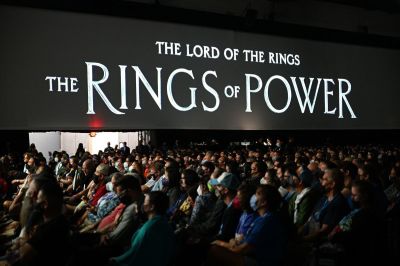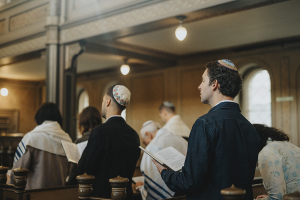‘The Lord of the Rings: The Rings of Power’ plays fast and loose with Tolkien’s world

Warning: This review contains spoilers for the Amazon series “The Lord of the Rings: The Rings of Power.”
Fans of J.R.R. Tolkien’s “The Lord of the Rings” and Peter Jackson’s fantastic three-film adaptation had many reasons to doubt that Amazon’s prequel streaming series would fail to deliver, not the least because the company and its CEO are generally Left-leaning.
Conservatives reacted with dismay when hearing that the show hired an intimacy coordinator, and some protested that black actors had no place in medieval British mythos. Yet the real weakness of “The Lord of the Rings: The Rings of Power” isn’t skin color or LGBT themes (of which there are none), or any other “woke” ideological threat.
The real problem with Amazon’s new “Lord of the Rings” show isn’t wokeness but disrespect for the realism of Tolkien’s world.
Many of the show’s characterizations fall flat and feel false to Tolkien’s work. The show turns mithril — the light and extra-sturdy metal mined by the dwarves — into a mystical metal that will keep the elves alive. It turns the men of Numenor — a noble race whom the elves blessed with long life — into shallow, squabbling ingrates who hate the elves for seemingly no reason.
The series also constantly changes the motivations of the main character, a young Galadriel (Morfydd Clark), from revenge to “I just can’t stop [fighting].” It creates a generic place name — “The Southlands” — which feels both lazy and out-of-place in a world with names such as Lindon, Gondor, Rohan, Rhovanion, and Mordor. When the show reveals that “The Southlands” became Mordor, it barely registers as a reveal because “The Southlands” always felt alien to the lore.
Yet the central failing of the show arguably comes in Episode 6, “Udun,” which ends with the climactic explosion of Mount Doom and the creation of Mordor. That episode features the central battle in the story, and that battle illustrates just how fast and loose Amazon plays with Tolkien’s lore.
Tolkien’s work laid the foundation of the modern fantasy genre, not because it was fantastic but because it felt real. Tolkien’s stories featured elves and wizards and dragons, but they centered on real characters and they resonated because they took place in a world that felt both different and familiar — in a world where getting anywhere important took a long time and a lot of effort, and where the darkness seems darkest just before the dawn.
Tolkien’s “The Lord of the Rings” introduces the audience to a fantastic new world through the lens of hobbits — people who are instantly relatable in their love for food, drink, and good company. Over the course of a journey that takes considerable time, these hobbits meet elves, dwarves, and men (among others), and each race comes into focus through the main characters. The world grows naturally out of the story, and it feels real because the hobbits have to go far and work hard to do anything worthwhile.
Perhaps the eagles could have flown Frodo Baggins (Elijah Wood in Jackson’s movies) to Mount Doom, so he could drop the One Ring into the fire from above, and spared the expense of this journey. That, however, would have been a rather poor excuse for a fantasy story. Sadly, it seems that Amazon took this inane idea as a model.
As Tolkien himself wrote: “I wisely started with a map, and made the story fit (generally with meticulous care for distances). The other way about lands one in confusions and impossibilities, and in any case it is weary work to compose a map from a story.”
“The Rings of Power” series throws out this successful formula entirely. Rather than focusing on one story, it takes on four: Galadriel, Elrond (Robert Aramayo), the proto-hobbits centered around Nori (Markella Kavenagh), and the men of the Southlands featuring the elf Arondir (Ismael Cruz Córdova) and Bronwyn (Nazanin Boniadi).
The series neatly grounds these distinct storylines as taking place simultaneously by showing a meteor crashing to earth in the first episode, bearing The Stranger (Daniel Weyman), who almost certainly will turn out to be Gandalf (Ian McKellen in the movies).
Yet the very grounding of these storylines creates a serious pacing problem. As Forbes’ Erik Kain notes, the Amazon show makes a journey of around 2,000 miles seem like it takes place in a day. The climactic battle of the sixth episode ends with a miraculous last-minute arrival — involving an army that was just leaving home in the last episode, the same fifth episode that featured the last-minute preparations for the battle 2,000 miles away. “The Rings of Power” doesn’t make any suggestion to the audience that time had been passing differently in the two locations.
Throughout the story, Galadriel travels from the far north to the elf capital of Lindon, across the sea close to Valinor (more than 2,00 miles), where she jumps off the boat and ends up on a raft with Halbrand, who turns out to be Sauron (Charlie Vickers). Elendil (Lloyd Owen) then rescues her and takes her to Numenor. Once there, Galadriel takes a fairly long time to convince Miriel (Cynthia Addai-Robinson), the effective ruler of Numenor, to summon an army. They take that army across 2,000 miles of sea and 200 miles of land to the main battle in the Southlands to save the day in the nick of time. Then Galadriel travels to Eregion, where the rings of power are finally forged in the final episode.
All of that convoluted plot around Galadriel takes place in one season, and to say it doesn’t line up with the Southlands storyline would be a vast understatement. The Southlands storyline takes place over the course of a few weeks that build to a climactic battle and the explosion of Mount Doom.
The last-minute save is an effective but dangerous storytelling device. If Numenor’s army comes in too soon or does not have an effective explanation for its arrival, it feels like a deus ex machina, a contrived rescue that does not fit the story.
Tolkien’s original “The Lord of the Rings” features an excellent example of a last-minute save done right: Gandalf’s arrival with the Rohirrim at Helm’s Deep. In Jackson’s film adaptation, Gandalf promises to return at a specific time, and the battle drags on, allowing Gandalf the requisite time to reach Eomer (Karl Urban), gather his cavalry, and arrive back in time to win the battle. The audience experiences this delay in real-time, and that makes the grand arrival all the more glorious.
By contrast, “The Rings of Power” features a few stilted lines of dialogue that might suggest that Halbrand and Galadriel know where the orcs are going to attack the men of the Southlands, but neither Halbrand nor Galadriel have any way of knowing when the attack will take place and they are not in contact with the men who are besieged by orcs.
Miraculously, however, they essentially teleport themselves across thousands of miles of sea and hundreds of miles of land in the nick of time — a classic deus ex machina.
The series suffers from other realism problems, as well. Although Galadriel, the Numenorians, and the men of the Southlands stand very close to Mount Doom when it erupts, spewing enough ash and dust to transform the land into a hellscape, almost none of them die. If only the residents of Pompeii had been so lucky.
The dialogue skirts the line between saccharine and just plain corny, and it borrows far too heavily from the superior Peter Jackson trilogy. Rather than playing it straight, the show strains to create memorable quotes but manages to be worse than forgettable.
To be sure, “The Rings of Power” does have something to show for its money. The sets — especially those of Numenor, Moria, and Lindon — are stunning and belong in the Tolkien-Jackson version of “The Lord of the Rings.” The costumes and visual effects also prove top notch. The music, which flowed from the mind of the excellent Bear McCreary with an assist from “Lord of the Rings” composer Howard Shore, proves superb.
Some of the storytelling works, especially the plot around The Stranger (although the suggestion that he might be Sauron seems forced) and the political intrigue among Elrond, Prince Durin IV (Owain Arthur), and Durin’s wife Disa (Sophia Nomvete).
When it comes to racial diversity, there is little logic to which characters are black and which are white, but the actors and actresses themselves do a good job portraying different characters and the show does a good job of emphasizing the differences among dwarves, elves, men, and hobbits regardless of the skin color of each character.
To say I am an avid fan of “The Lord of the Rings” would be an understatement. I grew up with the movies and the books, and my wife and I have proudly displayed photos of ourselves with actors Sean Astin (Sam Gamgee) and Billy Boyd (Peregrin Took). I once won a trivia contest because I correctly identified the specific opening music in “The Bridge of Khazad-Dum” from “The Fellowship of the Ring,” and I read through the original Tolkien books once again earlier this year. I sincerely hoped that “The Rings of Power” series would do justice to the books and the movies, and I defended the show early on when many conservatives rushed to condemn it (some without even having watched a single minute).
I came into the show with an open mind, but the show lost me because it trivializes Tolkien’s lore. This shoddy storytelling and worldbuilding may reveal a disdain for the audience — an attitude that says, “It’s no big deal, it’s just fantasy.” If nearly $500 million can buy Amazon anything, it should be enough to buy screenwriters wise enough to reject this flaccid mentality.
Originally published at The Daily Signal.
Tyler O'Neil is managing editor of The Daily Signal and the author of Making Hate Pay: The Corruption of the Southern Poverty Law Center.




























